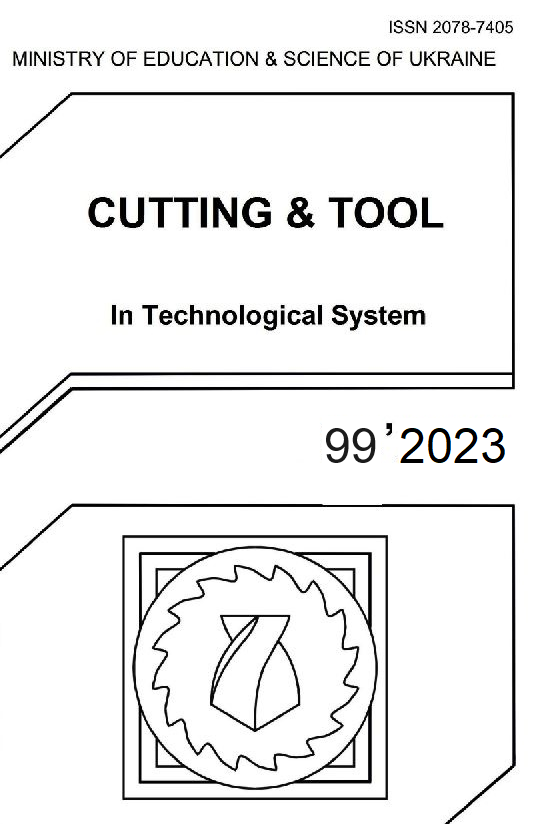INVESTIGATION OF ELECTRO DISCHARGE MACHINING OF TOOL STEELS BASED ON THE ROUGHNESS OF THE MACHINED SURFACES
DOI:
https://doi.org/10.20998/2078-7405.2023.99.04Keywords:
electrical discharge machining, functional roughness parameters, copper, graphite electrodesAbstract
In electro discharge machining (EDM or spark erosion) the roughness of the machined surface plays a very important role in the applicability of the process. This paper deals with a comparative study of the electro discharge machining of tool steels based on the roughness characteristics of the machined surfaces. Another aim of the research is to investigate which tool materials (electrode material, copper, or graphite) are most effective to achieve the best possible surface microgeometry. Based on the data of the performed cutting experiments and the subsequent measurements, conclusions will be drawn regarding the machinability of the tested tool steels and the applicability of the electrode materials used.
References
K. HHoS – T. Newman – S. Rahimifard – RD. Allen: State of the art in wire electrical discharge machining (WEDM), International Journal of Machine Tools and Manufacture, Volume 44, Issues 12–13, October 2004, pp. 1247–1259, https://doi.org/10.1016/j.ijmachtools.2004.04.017
A.A. Khan: Electrode wear and material removal rate during EDM of aluminum and mild steel using copper and brass electrodes. Int. J. Adv. Manuf. Technol. 39, рр. 482–487 (2008). https://doi.org/10.1007/s00170-007-1241-3
D’Urso, G., Maccarini, G. & Ravasio, C. Influence of electrode material in micro-EDM drilling of stainless steel and tungsten carbide. Int. J. Adv. Manuf. Technol. 85, 2013–2025 (2016). https://doi.org/10.1007/s00170-015-7010-9
V. Molnár, I. Sztankovics: Analysis of Roughness Parameters Determining Tribological Properties in Hard Turned Surfaces, Hungarian Journal Of Industry And Chemistry 49:2 (2021) рр. 77–84.
F.L. Amorim Walter - L. Weingaertner: The behaviour of graphite and copper electrodes on the finish die-sinking electrical discharge machining (EDM) of AISI P20 tool steel, J. Braz. Soc. Mech. Sci. & Eng. 29 (4) • Dec 2007, https://doi.org/10.1590/S1678-58782007000400004
I Puertas - CJ Luis - L Alvarez: Analysis of the influence of EDM parameters on surface quality, MRR and EW of WC–Co, Journal of Materials Processing Technology, Vol. 153–154, 10 November 2004, pp. 1026–1032, https://doi.org/10.1016/j.jmatprotec.2004.04.346
S.H. Lee - X.P. Li: Study of the effect of machining parameters on the machining characteristics in electrical discharge machining of tungsten carbide, Journal of Materials Processing Technology, Vol.115 (2001), pp. 344–358, https://doi.org/10.1016/S0924-0136(01)00992-X
E. L. Papazoglou - N. E. Karkalos - A. P. Markopoulos - P. Karmiris-Obratański: On the Machining of Aluminium Alloy AL6063 with EDM, Cutting & Tools in Technological System, 2020, Edition 93, pp. 76–87, doi: 10.20998/2078-7405.2020.93.09
M. Balanou - E. l. Papazoglou - A. P. Markopoulos - P. Karmiris-Obratański: Experimental Investigation of Surface Topoghraphy of AL7075-T6 alloy Machined by EDM, Cutting & Tools in Technological System, 2021, Edition 94, pp. 3–10, doi: 10.20998/2078-7405.2021.94.01
B. Mikó – Á. Drégelyi-Kiss – A. Poór: Study of surface quality and electrode wear in EDM technology, In: W, Zebala; I., Mankova (szerk.) Development in Machining Technology, Cracow, Poland: Cracow University of Technology Tadeusz Kosciuszko, (2014) pp. 194–211.
Downloads
Published
Issue
Section
License
Copyright Notice
Authors who publish with this Collection agree to the following terms:
1. Authors retain copyright and grant the Collection right of first publication with the work simultaneously licensed under a Creative Commons Attribution License that allows others to share the work with an acknowledgement of the work's authorship and initial publication in this Collection.
2. Authors are able to enter into separate, additional contractual arrangements for the non-exclusive distribution of the Collection's published version of the work (e.g., post it to an institutional repository or publish it in a book), with an acknowledgement of its initial publication in this Collection.
3. Authors are permitted and encouraged to post their work online (e.g., in institutional repositories or on their website) prior to and during the submission process, as it can lead to productive exchanges, as well as earlier and greater citation of published work.

